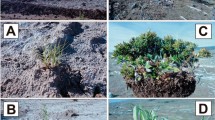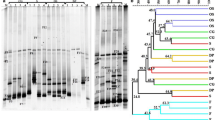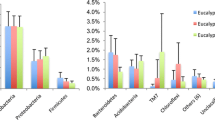Abstract
The relationships between plants and endophytic bacteria significantly contribute to plant health and yield. However, the microbial diversity in leaves of Eucalyptus spp. is still poorly characterized. Here, we investigated the endophytic diversity in leaves of hybrid Eucalyptus grandis x E. urophylla (Eucalyptus “urograndis”) by using culture-independent and culture-dependent approaches, to better understand their ecology in leaves at different stages of Eucalyptus development, including bacteria with N2 fixation potential. Firmicutes, Proteobacteria (classes alpha-, beta- and gamma-) and Actinobacteria were identified in the Eucalyptus “urograndis” endophytic bacterial community. Within this community, the species Novosphingobium barchaimii, Rhizobium grahamii, Stenotrophomonas panacihumi, Paenibacillus terrigena, P. darwinianus and Terrabacter lapilli represent the first report these bacteria as endophytes. The diversity of the total endophytic bacteria was higher in the leaves from the ‘field’ (the Shannon–Wiener index, 2.99), followed by the indices obtained in the ‘clonal garden’ (2.78), the ‘recently out from under shade (2.68), ‘under shade’ (2.63) and ‘plants for dispatch’ (2.51). In contrast, for diazotrophic bacteria, the highest means of these indices were obtained from the leaves of plants in the ‘under shade’ (2.56), ‘recently out from under shade (2.52)’ and ‘field’ stages (2.54). The distribution of the endophytic bacterial species in Eucalyptus was distinct and specific to the development stages under study, and many of the species had the potential for nitrogen fixation, raising the question of whether these bacteria could contribute to overall nitrogen metabolism of Eucalyptus.







Similar content being viewed by others
References
Addison SL, Foote SM, Reid NM, Lloyd-Jones G (2007) Novosphingobium nitrogenifigens sp. nov., a polyhydroxyalkanoate-accumulating diazotroph isolated from a New Zealand pulp and paper wastewater. Int J Syst Evol Microbiol 57:2467–2471
Al-Batayneh KM, Jacob JH, Hussein EI (2011) Isolation and molecular identification of new thermophilic bacterial strain of Geobacillus pallidus and Anoxybacillus flavithermus. Int J Integr Biol 11:39–43
Althabegoiti MJ, Ormeño-Orrillo E, Lozano L, Tejerizo GT, Rogel MA, Mora J, Martínez-Romero E (2014) Characterization of Rhizobium grahamii extrachromosomal replicons and their transfer among rhizobia. BMC Microbiol 14:1–14
Altimira F, Yáñez C, Bravo G, González M, Rojas LA, Seeger M (2012) Characterization of copper-resistant bacteria and bacterial communities from copper-polluted agricultural soils of central Chile. BMC Microbiol 12:1–12
Altschul SF, Gish W, Miller W, Myers EW, Lipman DJ (1990) Basic local alignment search tool. J Mol Biol 215:403–410
Bacon CW, Palencia ER, Hinton DM (2015) Abiotic and biotic plant stress-tolerant and beneficial secondary metabolites produced by Endophytic Bacillus Species. In: Arora NK (ed) Plant microbes symbiosis: applied facets. Springer, New Delhi, pp 163–177
Blackwood CB, Oaks A, Buyer JS (2005) Phylum- and class-specific PCR primers for general microbial community analysis. Appl Environ Microbiol 71:6193–6198
Bodenhausen N, Horton MW, Bergelson J (2013) Bacterial communities associated with the leaves and the roots of Arabidopsis thaliana. PLoS ONE 8:e56329
Bonito G, Reynolds H, Robeson MS, Nelson J, Hodkinson BP, Tuskan G, Schadt CW, Vilgalys R (2014) Plant host and soil origin influence fungal and bacterial assemblages in the roots of woody plants. Mol Ecol 23:3356–3370
Brader G, Compant S, Mitter B, Trognitz F, Sessitsch A (2014) Metabolic potential of endophytic bacteria. Curr Opin Biotechnol 27:30–37
Brooker MIH (2000) A new classification of the genus Eucalyptus L’Her (Myrtaceae). Aust Syst Bot 13:79–148
Bulgarelli D, Schlaeppi K, Spaepen S, Van Themaat EVL, Schulze-Lefert P (2013) Structure and functions of the bacterial microbiota of plants. Annu Rev Plant Biol 64:807–838
Castellanos DMO, Zabala LBB, Botía DIEGOR, Garrido MFR, Baldani VLD, Buitrago RRB (2010) Caracterización de Bacterias diazotróficas asimbióticas asociadas al eucalipto (Eucalyptus sp.) en Codazzi, Cesar (Colombia). Acta Biol Colomb 15:107–120
Castro RA, Quecine MC, Lacava PT, Batista BD, Luvizotto DM, Marcon J, Ferreira A, Melo IS, Azevedo JL (2014) Isolation and enzyme bioprospection of endophytic bacteria associated with plants of Brazilian mangrove ecosystem. SpringerPlus 3:1–10
Chen Y, Poland TM (2009) Interactive influence of leaf age, light intensity, and girdling on green ash foliar chemistry and emerald ash borer development. J Chem Eco 35:806–815
Chen C, Zhu H (2013) Are common symbiosis genes required for endophytic rice–rhizobial interactions? Plant Signal Behav 8:1–4
Da Silva MDCS, De Almeida PT, Moreira BC, Carolino M, Cruz C, Bazzolli DMS, Silva CC, Kasuya MCM (2014) Nitrogen-fixing bacteria in Eucalyptus globulus plantations. PLoS ONE 9:e111313
Dsouza M, Taylor MW, Turner SJ, Aislabie J (2014) Genome-based comparative analyses of Antarctic and temperate species of Paenibacillus. PLoS ONE 9:e108009
El-Deeb B, Fayez K, Gherbawy Y (2013) Isolation and characterization of endophytic bacteria from Plectranthus tenuiflorus medicinal plant in Saudi Arabia desert and their antimicrobial activities. J Plant Interact 8:56–64
Farrar K, Bryant D, Cope-Selby N (2014) Understanding and engineering beneficial plant–microbe interactions: plant growth promotion in energy crops. Plant Biotechnol J 2014(12):1193–1206
Ferreira A, Quecine MC, Lacava PT, Oda S, Azevedo JL, Araújo WL (2008) Diversity of endophytic bacteria from Eucalyptus species seeds and colonization of seedlings by Pantoea agglomerans. FEMS Microbiol Lett 287:8–14
Fidalgo C, Henriques I, Rocha J, Tacão M, Alves A (2016) Culturable endophytic bacteria from the salt marsh plant Halimione portulacoides: phylogenetic diversity, functional characterization, and influence of metal (loid) contamination. Environ Sci and Pollut Res 1:1–15
Figueroa CM, Diez MDA, Kuhn ML, Mcewen S, Salerno GL, Iglesias AA, Ballicora MA (2013) The unique nucleotide specificity of the sucrose synthase from Thermosynechococcus elongatus. FEBS Lett 587:165–169
Gaiero JR, Mccall CA, Thompson KA, Day NJ, Best AS, Dunfield KE (2013) Inside the root microbiome: bacterial root endophytes and plant growth promotion. Am J Bot 2013(100):1738–1750
Gazis R, Chaverri P (2010) Diversity of fungal endophytes in leaves and stems of wild rubber trees (Hevea brasiliensis) in Peru. Fungal Ecol 3:240–254
Hammer Ø, Harper DAT, Ryan PD (2001) PAST: paleontological statistics software package for education and data analysis. Palaeontol Electron 4:9
Han J, Xia D, Li L, Sun L, Yang K, Zhang L (2009) Diversity of culturable bacteria isolated from root domains of moso bamboo (Phyllostachys edulis). Microb Ecol 58:363–373
Hardoim PR, Overbeek LSV, Elsas KDV (2008) Properties of bacterial endophytes and their proposed role in plant growth. Trends Microbiol 16:463–471
Heuer H, Krsek M, Baker P, Smalla K, Wellington EMH (1997) Analysis of actinomycete communities by specific amplification of genes encoding 16S rRNA and gel-electrophoretic separation in denaturing gradients. Appl Environ Microbiol 63:3233–3241
Jackson CR, Randolph KC, Osborn SL, Tyler HL (2013) Culture dependent and independent analysis of bacterial communities associated with commercial salad leaf vegetables. BMC Microbiol 13:1–12
Kämpfer P, Sessitsch A, Schloter M, Huber B, Busse HJ, Scholz HC (2008) Ochrobactrum rhizosphaerae sp. nov. and Ochrobactrum thiophenivorans sp. nov., isolated from the environment. Int J Syst Evol Micrbiol 58:1426–1431
Kannan R, Damodaran T, Umamaheswari S (2015) Sodicity tolerant polyembryonic mango root stock plants: a putative role of endophytic bacteria. Afr J Biotechnol 14:350–359
Kembel SW, O’connor TK, Arnold HK, Hubbell SP, Wright SJ, Green JL (2014) Relationships between phyllosphere bacterial communities and plant functional traits in a neotropical forest. Proc Natl Acad Sci 111:13715–13720
Kerfeld CA, Scott KM (2011) Using BLAST to Teach ‘‘e-value-evotionary’’ Concepts. PLoS Biol 9:1–4
Köberl M, Schmidt R, Ramadan EM, Bauer R, Berg G (2013) The microbiome of medicinal plants: diversity and importance for plant growth, quality and health. Front Microbiol 4:1–9
Köppen W (1948) Climatologia. Fundo de Cultura Econômica, México
Kukla M, Płociniczak T, Piotrowska-Seget Z (2014) Diversity of endophytic bacteria in Lolium perenne and their potential to degrade petroleum hydrocarbons and promote plant growth. Chemosphere 117:40–46
Leff JW, Del Tredici P, Friedman WE, Fierer N (2015) Spatial structuring of bacterial communities within individual Ginkgo biloba trees. Environ Microbiol 17:1–10
Li X, Rui J, Xiong J, Li J, He Z, Zhou J, Yannarell AC, Roderick I, Mackie RI (2014) Functional potential of soil microbial communities in the maize rhizosphere. PLoS ONE 9:e112609
Liba CM, Ferrara FIS, Manfio GP, Fantinatti-Garboggini F, Albuquerque RC, Pavan C, Ramos PL, Mireira-Filho CA, Barbosa HR (2006) Nitrogen-fixing chemo-organotrophic bacteria isolated from cyanobacteria-deprived lichens and their ability to solubilize phosphate and to release amino acids and phytohormones. J Appl Microbiol 101:1076–1086
Malik KA, Claus D (1979) Xanthobacter flavus, a new species of nitrogen-fixing hydrogen bacteria. Int J Syst Evol Microbiol 29:283–287
Mankessi F, Saya AR, Boudon F, Guédon Y, Montes F, Lartaud M, Verdeil JL, Monteuuis O (2010) Phase change-related variations of dome shape in Eucalyptus urophylla × Eucalyptus grandis shoot apical meristems. Trees 24:743–752
Mapelli F, Marasco R, Rolli E, Barbato M, Cherif H, Guesmi A, Ouzari I, Daffonchio D, Borin S (2013) Potential for plant growth promotion of rhizobacteria associated with Salicornia growing in Tunisian hypersaline soils. Biomed Res Int 2013:1–14
Miguel PSB, Delvaux JC, Oliveira MNV, Monteiro LCP, Freitas FS, Costa MD, Tótola MR, Moraes CA, Borges AC (2013) Diversity of endophytic bacteria in the fruits of Coffee canephora. Afr J Microbiol 7:586–594
Minitab I (2006) MINITAB statistical software. Version: Release, 15
Naher UA, Radziah O, Halimi MS, Shamsuddin ZH, Razi IM (2008) Specific growth rate and carbon sugar consumption of diazotrophs isolated from rice rhizosphere. J Biol Sci 8:1008–1014
Niharika N, Moskalikova H, Kaur J, Sedlackova M, Hampl A, Damborsky J, Prokop Z, Lal R (2013) Novosphingobium barchaimii sp. nov., isolated from a hexachlorocyclohexane (HCH) contaminated soil. Int J Syst Evol Microbiol 63:667–672
Ofek M, Hadar Y, Minz D (2012) Ecology of root colonizing Massilia(Oxalobacteraceae). PLoS ONE 7:e40117
Oldroyd GED, Dixon R (2014) Biotechnological solutions to the nitrogen problem. Curr Opin Biotechnol 26:19–24
Oliveira MNV, Santos TMA, Vale HMM, Delvaux JC, Cordero AP, Ferreira AB, Miguel PSB, Tótola MR, Costa MD, Moraes CA, Borges AC (2013) Endophytic microbial diversity in coffee cherries of Coffea arabica from southeastern Brazil. Can J Microbiol 2013(59):221–230
Petersen DG, Dahllöf I (2005) Improvements for comparative analysis of changes in diversity of microbial communities using internal standards in PCR-DGGE. FEMS Microbiol Ecol 53:339–348
Poly F, Ranjard L, Nazaret S, Gourbière F, Monrozier LJ (2001) Comparison of nifH gene pools in soils and soil microenvironments with contrasting properties. Appl Environ Microbiol 67:2255–2262
Portais JC, Delort AM (2002) Carbohydrate cycling in micro-organisms: what can 13C-NMR tell us? FEMS Microbiol Rev 26:375–402
Priest TFG, Genus I (2009) Paenibacillus. In: De Vos P, Garrity GM, Jones D, Krieg NR, Ludwig W et al (eds) Bergey’s manual of systematic bacteriology the firmicutes. Springer, New York
Procópio REL, Araújo WL, Maccheroni JRW, Azevedo JL (2009) Characterization of an endophytic bacterial community associated with Eucalyptus spp. Genet Mol Res 2009(8):1408–1422
Puri A, Padda KP, Chanway CP (2016a) Seedling growth promotion and nitrogen fixation by a bacterial endophyte Paenibacillus polymyxa P2b-2R and its GFP derivative in corn in a long-term trial. Symbiosis 1:1–7
Puri A, Padda KP, Chanway CP (2016b) Evidence of nitrogen fixation and growth promotion in canola (Brassica napus L.) by an endophytic diazotroph Paenibacillus polymyxa P2b-2R. Biol Fert Soils 52:119–125
Ramos PL, Van Trappen S, Thompson FL, Rocha RC, Barbosa HR, De Vos P, Moreira-Filho CA (2014) Screening for endophytic nitrogen-fixing bacteria in Brazilian sugar cane varieties used in organic farming and description of Stenotrophomonas pavanii sp. nov. Int J Syst Evol Microbiol 61:926–931
Reasoner DJ, Geldreich EE (1985) A new medium for the enumeration and subculture of bacteria from potable water. Appl Environ Microbiol 49:1–7
Reinhold-Hurek B, Hurek T (2011) Living inside plants: bacterial endophytes. Curr Opin Plant Biol 14:435–443
Rodionov DA, Yang C, Li X, Rodionova IA, Wang Y, Obraztsova AY, Zagnitko OP, Overbeek R, Romine MF, Reed S, Fredrickson JK, Nealson KH, Osterman AL (2010) Genomic encyclopedia of sugar utilization pathways in the Shewanella genus. BMC Genom 11:494
Romero FM, Marina M, Pieckenstain FL (2014) The communities of tomato (Solanum lycopersicum L.) leaf endophytic bacteria, analyzed by 16S-ribosomal RNA gene pyrosequencing. FEMS Microbiol Lett 351:187–194
Saitou N, Nei M (1987) The neighbor-joining method: a new method for reconstructing phylogenetic trees. Mol Biol Evol 4:406–425
Santoyo G, Moreno-Hagelsieb G, del Carmen Orozco-Mosqueda M, Glick BR (2016) Plant growth-promoting bacterial endophytes. Microbiol Res 183:92–99
Schneider H (2007) Métodos de análise filogenética: um guia prático (Methods for phylogenetic analysis: a practical guide). Holos Editora e Sociedade Brasileira de Genética, Ribeirão Preto
Scolforo JRS, Oliveira AD, Carvalho LMT (eds) (2008) Zoneamento ecológico-econômico do Estado de Minas Gerais: componente socioeconômico. UFLA, Lavras
Seo WT, Lim WJ, Kim EJ, Yun HD, Lee YH, Cho KM (2010) Endophytic bacterial diversity in the young radish and their antimicrobial activity against pathogens. J Korean Soc Appl Biol Chem 53:493–503
Smethurst P, Holz H, Moroni M, Baillie C (2004) Nitrogen management in Eucalyptus nitens plantations. For Ecol Manage 193:63–80
Stackebrandt E, Ebers J (2006) Taxonomic parameters re-visited: tarnished gold standards. Microbiol Today 33:152–155
Steinbauer J (2013) Shoot feeding as a nutrient acquisition strategy in free-living psylloids. PLoS ONE 8:1–9
Summan A, Gaur A, Shrivastava AK, Yadav RL (2005) Improving sugarcane growth and nutrient uptake by inoculating Gluconacetobacter diazotrophicus. Plant Growth Regul 47:155–162
Systat Software, Inc. (2008). SigmaPlot for Windows, version 11.0
Szilagyi-Zecchin VJ, Ikeda AC, Hungria M, Adamoski D, Kava-Cordeiro V, Glienke C, Galli-Terasawa LV (2014) Identification and characterization of endophytic bacteria from corn (Zea mays L.) roots with biotechnological potential in agriculture. AMB Express 4:1–9
Turner TR, James EK, Poole PS (2013) The plant microbiome. Genome Biol 14:1–10
Vandenkoornhuyse P, Quaiser A, Duhamel M, Le Van A, Dufresne A (2015) The importance of the microbiome of the plant holobiont. New Phytol 206:1196–1206
Velázquez-Hernández ML, Baizabal-Aguirre VM, Cruz-Vázquez F, Trejo-Contreras MJ, Fuentes-Ramírez LE, Bravo-Patiño A, Cajero-Juárez M, Chávez-Moctezuma MP, Valdez-Alarcón JJ (2011) Gluconacetobacter diazotrophicus levansucrase is involved in tolerance to NaCl, sucrose and desiccation, and in biofilm formation. Arch Microbiol 193:137–149
Waqas M, Khan AL, Kamran M, Hamayun M, Kang SM, Kim YH, Lee IJ (2012) Endophytic fungi produce gibberellins and indoleacetic acid and promotes host-plant growth during stress. Molecules 17:10754–10773
Weber OB, Videira SS, De Araújo JLS (2013) Identification of culturable endophytes in ‘Champaka’ pineapple grown in an organic system. Afr J Agric Res 8:3422–3430
Wemheuer F, Wemheuer B, Kretzschmar D, Pfeiffer B, Herzog S, Daniel R, Vidal S (2016) Impact of grassland management regimes on bacterial endophyte diversity differs with grass species. Lett Appl Microbiol 62:323–329
West ER, Cother EJ, Steel CC, Ash GJ (2010) The characterization and diversity of bacterial endophytes of grapevine. Can J Microbiol 56:209–216
Yi H, Srinivasan S, Kim MK (2010) Stenotrophomonas panacihumi sp. nov., isolated from soil of a ginseng field. J Microbiol 48:30–35
Acknowledgments
The authors thank the Celulose Nipo-Brasileira (CENIBRA) for financial support, Federal Agency for Support and Evaluation of Graduate Education (Coordenação de Aperfeiçoamento de Pessoal de Nível Superior—CAPES) for financial support and the Minas Gerais State Research Foundation (Fundação de Amparo à Pesquisa do Estado de Minas Gerais—FAPEMIG) for the grant provided to the first author.
Author information
Authors and Affiliations
Corresponding author
Rights and permissions
About this article
Cite this article
Miguel, P.S.B., de Oliveira, M.N.V., Delvaux, J.C. et al. Diversity and distribution of the endophytic bacterial community at different stages of Eucalyptus growth. Antonie van Leeuwenhoek 109, 755–771 (2016). https://doi.org/10.1007/s10482-016-0676-7
Received:
Accepted:
Published:
Issue Date:
DOI: https://doi.org/10.1007/s10482-016-0676-7




